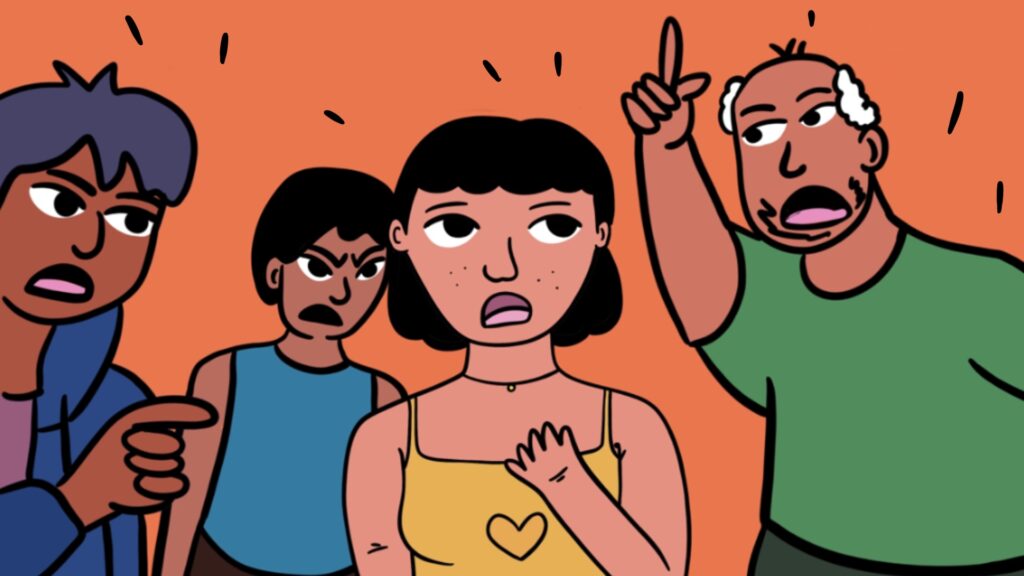After the horrific Nirbhaya rape case incident, Delhi was again shocked with the news of the gruesome murder of of Shraddha Walker, allegedly committed by her live-in partner, Aftab Amin Poonawala. The shocking revelation in her letter submitted a few years ago at Tulinj Police station in Maharashtra has highlighted how she was suffocating in her traumatic and toxic relationship.
Apparently, from the letter, she seems helpless and entangled in the middle-class gentility loop, where, despite being threatened multiple times by her live-in partner, she preferred to persist in a violent relationship rather than be judged, victimized and questioned by a patriarchal society that oxymoronically glee on a misfortune suffered by independent women. Moreover, her presumptions did come true with the agenda-driven narrative dawned by the prime-time news agencies and social media following the revelation of her murder.
The insensitive discourse peddled by media houses and social media clickbaits with hashtags like #MeraAbdulAisaNahiHai, #LoveJihad, #Suitcase, and #Fridge gave further ammunition to Hindu zealots to propagate the Hindutva ideology of hegemonic masculinity.
The dialectic in media veers off from physical violence. The prime times with their hyper-nationalist anchors, and the morality trolls on social media initiated the narrative around the bogey of Love Jihad. The essential questions about women’s safety were not asked, nor were efforts made to analyse why domestic violence is prevalent and accepted by our society. What affirmative actions could the government establish to provide non-judgmental support to the victim of intimate partner violence in a gender discriminated society?
What steps could a family take to create a safe and sensitive environment so that women could share their ordeals without being stigmatized? What changes in moral education should be brought under National Education Policy so that edifice of hegemonic masculinity could be countered at the outset- while ensuring that young boys understand that physical violence against a wife/girlfriend/live-in partner is not acceptable just because they are male?
Also Read: Shraddha Walkar Murder: A Grave Reflection On Unaddressed Issue Of Intimate Partner Violence
Rational arguments that could prevent such violent physical abuse incidents against women through which Shradha had to go are plenty. However, ideologically narrative-driven media is more fascinated with walking on the rope of communal bigotry to sensationalize the news for the majoritarian audience rather than genuinely showing concern for physical violence victims by addressing the crux of the matter, i.e., the pervasive culture of hegemonic masculinity.
Love Jihad, a win-win narrative for the votaries of hegemonic masculinity
The fetishization of Love Jihad is not a new notion among the proselytizers of Hindutva doctrine. The rhetoric of Muslim violence against Hindu women- manifesting women as a national symbol- and marginalizing women’s agency to protect national honour and Hindu Dharma was an essential part of mobilizing the Hindu fundamentalists during the nationalist movement in the pre-colonial era.
The Hindutva ideologues who took inspiration from the Nazis of Germany developed a hegemonic masculine Hindu identity during this nationalist phase. One of the types of masculinity that R.W Cornel, in his gender order theory, illustrates it as the legitimization of alpha male dominance over female and beta males in society.
Also Read: Love Jihad Law: Making Hindu Women ‘Nirbhar’ In ‘Aatmanirbhar’ India
The idea behind propagating this masculine identity was to control women within the family, public, and social spheres. Moreover, in this period, Hindu women’s sexuality was interlinked with religion and nationalism- and Hindutva charlatans constructed various ambiguous identities around her- under which desexualized and subdued women were only considered moral and nationalist.
Ironically this notion of morality, adopted by Hindu nationalists, was borrowed from Victorian morality, within which colonizers used to judge women’s morals based on their sexuality. The less sexually liberated women, the highly moral she was seen in the colonial regime.
Thereby, the Hindutva hegemonic masculinity developed within the folds of Hindu nationalism and till now persists in post-colonial India was an amalgamation of Nazis-inspired masculinity and colonial-defined morality, what the author of this piece in his research calls ‘Hindu Victorian morality’. The sinister rationality behind legitimizing this pervasive culture of hegemonic masculinity was to maintain the binary of ‘us vs them’. Making sure that an atmosphere of anxiety is always there so that the subjugation of Muslim men and Hindu women under the gaze of Hindutva hegemonic masculinity is justified to protect religion and nationalism.

However, this propaganda to establish hegemonic masculinity culture to check gender based violence against Hindu women has only harmed the victims of violence. Under the pervasive culture of Hindu hegemonic masculinity, physical violence is only considered a violent act if a sufferer is a Hindu woman and the culprit is a Muslim man (What they call Love Jihad). Otherwise, gender-based violence remains unrecognized.
Also Read: Victim Blaming, Love Jihad And Islamophobia: Is There A Room For Justice For Women In India?
Even if it gets recognized, it is justified and legitimized under Hindu hegemonic masculinity- as an act- to control and make Hindu women moral and disciplined so that they can stay away from the evil eyes of Muslims. It wouldn’t be wrong to argue that Love Jihad remains a win-win narrative for Hindutva votaries, who used this fallacy to legitimize their masculine dominance over subaltern groups while utilizing media as its propaganda tool to create fear and anxiety.
Media establishing the path for theocratic Rashtra
The media may not have changed what happened with Sharadha, but their rationalist discourse might have saved many women from gender-based violence. However, except for the few independent digital media platforms, the rest, from prime-time to social media to right-wing digital platforms, were more focused on victim-blaming and justifying why hegemonic masculinity is required within the Hindu community.
The rhetoric of Love Jihad was again propagated; the questions on women’s sexuality were again asked; her identity was again linked with nationalism and religion. The media was basically filled with abhorrent questions, one being whether a Hindu woman should be given that much freedom to choose where she wants to live and with whom she wants to live.
A question that forced the writer of this piece to wonder whether the media is providing a space and propagating an ideological narrative that legitimises the fallacy of Hindutva ideologues of having a Hindu theocratic Rashtra.

Currently, this notion of theocratic Hindu Rashtra might sound hyperbolic to the readers; however, the media is leaving no stone unturned with the help of their agenda-driven narrative to pivot a pluralist Indian society into a theocratic Rashtra.
A Rashtra in which women’s freedom and the agency will be challenged; a Rashtra that will justify the presence of Hindu hegemonic masculinity and its subjugation of subaltern groups; a Rashtra that will only question gender-based violence if the offender belongs to minority groups.
About the author(s)
Satkirti Sinha is a Graduate Teaching Assistant and a PhD research scholar in the Performing Arts Department at DMU University, Leicester. His areas of expertise are Performance Theory, Folk Culture, Dalit Theology, Performance Politics, Feminist Theory, Postcolonial Theory, and Sexual Politics.





